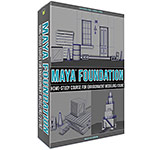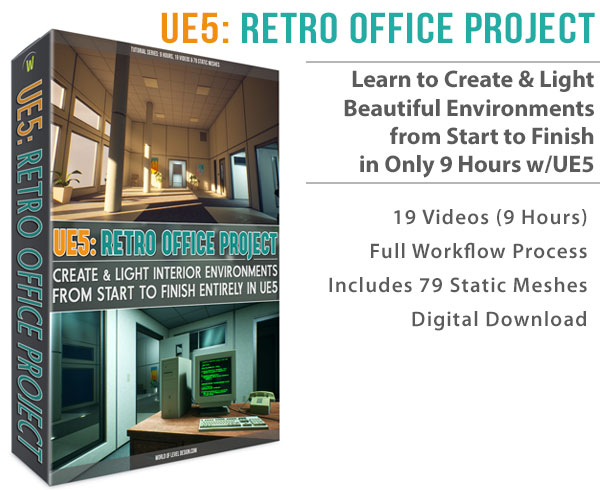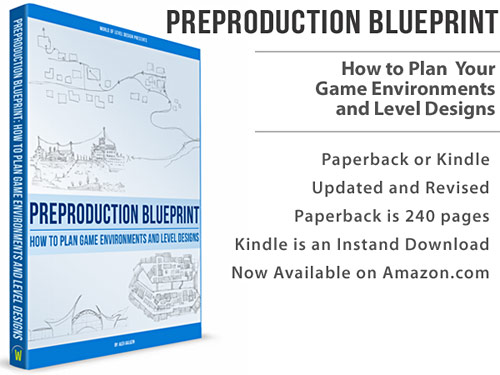World of Level Design™
Tutorials to Becoming the Best Level Designer and Game Environment Artist (since 2008)

I have NEVER heard of Redshift before. But once I started using it I was impressed.
What is Redshift?
Redshift is a GPU based render. Most renders are CPU based but not this one. Requirements for Redshift favor Nvidia based graphics cards, so it won't work with AMD. You can see full specs here.
After having to learn and teach Redshift, I really like it. I see why many people prefer it. It is fast and creates great results.
In this tutorial series, I will share the complete tutorial guide to getting started with Redshift for Maya.
Tutorial Series Outline:
- Redshift Setup, Interface Overview and Rendering Your First Frame
- How to Use 4 Standard Redshift Lights (Directional, Point, Spot, Area)
- HDRI Image-Based Lighting with a Dome Light
- Redshift Materials: Basic Setup for Non-Metals and Metals (Metalness Workflow)
- Redshift Materials: Texture Setup for Non-Metals and Metals (Metalness Workflow)
- Redshift Materials: Roughness and Metallic Values Explained (Metalness Workflow)
- Redshift Materials: Creating and Rendering Glass Surfaces Quickly
- Redshift Materials: How to Setup and Use Displacement Textures
- Redshift Materials: How to Setup Emissive Materials
Redshift Setup, Interface Overview and Rendering Your First Frame
Enabling Redshift Plugin
If you don't see Redshift drop down menu and a Redshift Toolshelf after installing Redshift, you may need to enable the plugin.
Windows > Settings/Preferences > Plugin Manager and enable Loaded and Auto-Loaded:

Everything you need to use Redshift will be found under the Redshift Tool Shelf but you also have a drop down menu for Redshift:


Render Your First Frame
First four red icons are:
- Render View
- Render Current Frame
- IPR (Interactive Photorealistic Render)
- Render Settings

Click on Render View and click on Render Frame:

You can use Maya Render View instead of Redshift Render View. Just make sure to use the drop down menu to select Redshift as your renderer. However, I find it easier to use Redshift Render.
To render you need some lights in the scene. Otherwise it will use default Maya lighting. Only use Redshift lights if rendering with Redshift.
Redshift lights are found in the 5 yellow icons:

If you right-click on the first icon, it will give you access to 4 standard Redshift lights:

- Area Light
- Point Light
- Spot Light
- Directional Light
Click on Render to render your first frame. It will render from the current point of view you have active. Later on I'll show you how to insert a camera to render from. For now just render using the current viewport view.
Setting Screenshot Sizes
Render Settings controls the quality and size of your render as well as how Redshift Render is being used. There are many settings here. For now we are only focused on Screenshot Resolution.
To render at a specific resolution go to Render Settings and under Common tab go to Resolution > Presets and choose one of the presets you want to use such as 1080HD or other:

Navigation in Redshift Render
Navigate within the Render view:
- Hold Alt+RMB = Zoom
- Hold Alt+MMB = Pan
- F = Frame View
Bucket Rendering and IPR Rendering
Bucket Rendering will render your current frame at the quality you have set in the Render Settings. This will be your final rendered frame when you are ready to save the screenshot.
IPR stands for Interactive Photorealistic Render. It renders everything in real-time and updates as you move the camera, change lights or update materials.
- Bucket Rendering is when you are ready to save your final rendered frame
- IPR is good for work in progress

Taking and Saving Screenshots
Take work-in-progress screenshot of your renders. This is great for checking your work with before and after. Click on the Take Screenshot icon and all images will appear below:

To delete, select a screenshot below and hit Delete.
Click on the Screenshots icon to toggle the Screenshot panel view:

To save a screenshot go to File > Save Image As then choose format, name it and Save:

Using a Camera
Common method of rendering is to set up a camera to rendering from instead of using your perspective viewport. To do this you need a camera.
Go to Create > Cameras > Camera:

I usually scale the camera so I can see it in the viewport and find it easier.
To view from the camera to set it up in the viewport, go to Panels > Perspective > Camera1:

Make sure you are rendering from the Camera and not Perspective, you may need to select your camera from the drop-down menu in the Redshift Render View:

Position your shot then exit by going to Panels > Perspective > Persp:

How to Use 4 Standard Redshift Lights (Directional, Point, Spot, Area)
There are 4 standard lights in Redshift. These are very common across many renders and software. You'll probably be familiar with them.
- Area Light
- Point Light
- Spot Light
- Directional Light
Many of these lights have similar properties between each other such as Intensity, Color, Temperature, Shadow etc.
In Redshift Tab right click on this icon and choose a light to insert:

Go to Attribute Editor to adjust each light's properties.
Applies to All Lights
General notes that apply to all 4 standard lights:
- Don't have more than 1 directional light.
- You can have more than 1+ light for Point Lights, Spot Lights and Area Lights.
- Delete lights by selecting them and hitting Delete.
- Duplicate lights with Ctrl+D.
- Scaling Spot, Point or Directional light doesn't affect intensity.
- Scaling Area Lights changes their area of effect and intensity.
- Rename any light using the Outliner or through the Channel Box.
Light properties that apply to all 4 standard lights:
- Intensity Multiplier changes the intensity of the light.
- Each light's color can be adjusted with Color or Temperature or both but I tend to work with either Color or Temperature.
- You can turn off any light by disabling On in General tab.

Shadows
Light shadow properties that apply to all 4 standard lights:
- Adjust Shadow Softness, Transparency and Sample (shadow quality) under the Shadow tab.
- If you want soft shadows, increase Softness above 1; 5 is a good starting value.
- You can also turn off cast shadows for any light.
- Transparency or opacity is for cast shadow only
- Samples is the quality of your shadow (per light) but you can set Samples globally for the entire scene under Unified sampling Max Samples:

Directional Light
Directional Light properties to note:
- Only have 1 Directional Light in the scene; this is your sun or moon.
- Default intensity of 100 is too strong. Change it to 1.
- Position of Directional light in the scene doesn't matter, only the angle does.

Point Light
Point Light properties to note:
- Point Light is your light bulb.
- Intensity may need to be increased, default of 100 is too low.
- Decay in light's properties is distance and time over which the light begins to fade and dies out. Default Inverse-square is close to real world decay.

Spot Light
Spot Light properties to note:
- Spot has additional properties such as Cone Angle, Falloff Angle, Fall-off Curve.
- Cone Angle: is the size of the spot light.
- Falloff Angle: how hard or soft the transition is at the outer edge of the spot light.
- Decay in light's properties is distance and time over which the light begins to fade and dies out. Default Inverse-square is close to real world decay.

Area Light
Area light has a shape and a light source:

Area Light properties to note:
- Area light has a shape and a light source.
- Turn off the light source by disabling Visible property.
- Bi-directional will have light appear on both sides of the Area light.
- You can change the shape to Rectangle, Disc, Sphere, Cylinder and Mesh.

Assign a Mesh to Area Lights
Assign a mesh to an Area light so it becomes the light source.

- Set Shape: Mesh
- Choose mesh object first and Area light second
- Click Link
- To disconnect, select the mesh and click Unlink
Use HDR Image-Based Lighting with Dome Light
HDRI stands for High Dynamic Range Image. Many software allow you to use HDR images to light environments with. Maya with Redshift is one of them.
These images are usually HDR or EXR format. You use these images within a Dome Light in Redshift. Then once rendered, that image is used to light the scene.
Websites for HDR Images
How to Use HDR Images
To use HDR images in Redshift is easy. You need a Dome Light.
Go to Redshift Tab and insert a Dome Light:

With light selected, go to Attribute Editor and under Image click on the folder icon:

Select an HDR image you want to use. Your scene will use that image as its light source. You can rotate the Dome Light to adjust the direction of the light.
You can disable the Background visibility under Visible Background. This will simply turn on or off the image itself but not the light from it:

You can adjust Exposure making the light intensity brighter or darker:

Redshift Materials: Basic Setup for Non-Metals and Metals (Metalness Workflow)
PBR stands for Physically Based Rendering and it simulates how real light works but in 3d.
PBR uses two different workflow types. You will use one or the other depending on the software.
- Metallic Roughness workflow
- Specular Glossiness workflow
Redshift uses metallic roughness workflow and here is how to set it up to make it work. This method resembles the one used in UE4.
If you are using Redshift Renderer then you should use Redshift Materials.
In Hypershade you will find various Redshift materials to choose from. The one you want to use for most of your standard material types is Redshift Material:

Change the following settings for the Redshift Material before using it:
- BRDF: GGX
- Fresnel: Metalness

The Roughness input controls how rough or shiny a Material's surface is. You may use any value between 0 and 1.
Redshift Roughness Constant Values:
- 0 = Shiny
- 1 = Rough

Redshift Metallic Constant Values:
- 0 = Non-Metallic
- 1 = Metallic
Metallic should be set to 0 or 1. Not anywhere in between. Unless you are using Metallic texture which will control where the metals and non-metals of that surface will be. More on this later.

Simple Standard Material Setup (Non-Metallic)
- Metalness: 0
- Roughness: from 0 to 1
- Adjust Color under Diffuse
Simple Standard Material Setup (Metallic)
- Metalness: 1
- Roughness: from 0 to 1
- Adjust Color under Diffuse
Redshift Materials: Texture Setup for Non-Metals and Metals (Metalness Workflow)
Material setup with textures for Metalness PBR workflow requires a bit of setup, especially for Roughness and Normal Maps.
Albedo is simple to do and requires no additional setups:

Roughness Map requires the following:
- Color Space: Raw
- Use one of the existing color channels (R, G or B) and reconnect it into Reflection Roughness


Normal Map requires the following:
- Bump Map = Normal Map
- Normal Map input is found under Overall tab of the Material in Property Editor or Attribute Editor
- Color Space: Raw
- Input Map Type: Tangent Space Normal
- Height Scale: 1.0



If setting up a Metallic Material with a texture instead of Metalness Constant value use the following setup (similar to Roughness):
- Color Space: Raw
- Use one of the existing color channels (R, G or B) and reconnect it into Reflection Metalness


Redshift Materials: Roughness and Metallic Values Explained (Metalness Workflow)
Redshift Roughness Constant Values:
- 0 = Shiny (black)
- 1 = Rough (white)
Roughness Gray Scale Values:
- Black = Shiny, very reflective
- White = Rough, not shiny/reflective
Redshift Metallic Constant Values:
- 0 = Non-Metallic (black)
- 1 = Metallic (white)
Redshift Metallic Values:
- Black = NOT Metallic
- White = Metallic


Redshift Materials: Creating and Rendering Glass Surfaces Quickly
Creating glass in Redshift is simple to do. It requires you to create a separate material and adjust few properties for how you want the glass to look.

Create a Redshift Material and change the following:
- BRDF: GGX
- Fresnel Type: IOR
In previous tutorials and materials I've shown you, I've changed Fresnel Type to Metalness. For glass, I keep it at IOR.
"IOR stands for Index Of Refraction and controls how much light is deviated when bouncing off a reflective material. A value of 1 causes no change in direction, meaning that it has the same density as air."
Change the following properties to start rendering glass:
- Refraction/Transmission: increase Weight to .9 (adjust this value to get different glass refraction.
- Enable/Disable Thin Walled depending on the glass type.
- Change Roughness with a value or a teture to make glass material more or less reflective.
- Adjust IOR by increasing the default value 1.5 to see different glass results.

Adjust all these values back and forth depending on what glass effect you want to get.
There is more to glass materials than this basic setup, but what I've shown you is enough to get you started creating glass surfaces.
Redshift Material: How to Setup and Use Displacement Textures
Displacement texture uses a grayscale image and displaces or modifies object geometry based on black/white values.
You can use displacement textures to quickly create detailed geometry without having to model or sculpt. Here is a very quick example I created and it took me less than 10 minutes:

You can create your own displacement (heightmap) textures with various software or you can get some PBR textures from many online sources such as these:
To set up displacements in Redshift you need the following:
- Redshift Material
- rsDisplacement node (Redshift Displacement)
Create a Redshift Material and in Hypershade Graph View, hit Tab to begin searching for a material node. Search for RedshiftDisplacement:

Connect the Displacement node into your Material Shader Group:

Then do the following:
- Assign a displacement texture
- Leave it as sRGB and Out Color into TexMap

Controlling displacement on geometry is done at the object level. Select your object and go into Attribute Editor. In my case I have a simple plane with default subdivisions applied.
- Select the geometry and in Attribute Editor
- Redshit tab: enable Tessellation and Displacement
- Change Displacement Scale and then Discplacement Height; both of these values may need to be adjusted at the same time. Usually changing Displacement Scale will do what it needs to do
- Adjust Min Edge Length Tessellation if the modified geometry is creating a lot of stretching
- Adjust Tesselation change the resoution of subidivions applied to your gometry at render time

Displacement Texture Grayscale Values:
- Black = lowers geometry
- White = raises geometry
Custom Heightmaps/Displacement in PS:
- Document should be Grayscale at 16bit
- Save as PNG or TIF
- Black will lower geometry
- White will raise geometry
- Medium Gray should the middle base value so you can lower and raise geometry
Further Resource on Redshift Displacement and Tessellation.
Redshift Material: How to Setup Emissive Materials
Emissive material will make the surface glow regardless of the lighting in the scene. This is great to use for phone screens, phone screens, computer monitors or any other light sources.

You can have a separate material for Emissive or you can apply this material to selected set of faces.
Here is how to make Emission (Emissive) work:
- Emissive property is found under Overall
- Emission controls the color of your Emissive material
- Black is nothing, no emissive property applied (this applies to a texture as well)
- Increase Emission Weight to turn on Emission and change it from black color to any other color (or use a custom texture)

Home Terms of Use/Trademarks/Disclaimers Privacy Policy Donate About Contact
All content on this website is copyrighted ©2008-2024 World of Level Design LLC. All rights reserved.
Duplication and distribution is illegal and strictly prohibited.
World of Level Design LLC is an independent company. World of Level Design website, its tutorials and products are not endorsed, sponsored or approved by any mentioned companies on this website in any way. All content is based on my own personal experimentation, experience and opinion. World of Level Design™ and 11 Day Level Design™ are trademarks of AlexG.
Template powered by w3.css


 Maya Foundation: Home-Study Course - Model and UV Environments
Maya Foundation: Home-Study Course - Model and UV Environments Substance 3D Painter Essentials - Master Texturing
Substance 3D Painter Essentials - Master Texturing UE5: Fundamentals Vol.1 - Create with Unreal Engine 5
UE5: Fundamentals Vol.1 - Create with Unreal Engine 5 UE5: Retro Office Project - Create Beautiful Interior Env
UE5: Retro Office Project - Create Beautiful Interior Env UE5: Master Material Creation - Create Master Materials in UE5
UE5: Master Material Creation - Create Master Materials in UE5



